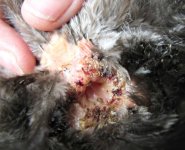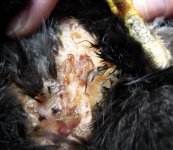elmwood
New member
Hi,
All 5 of my birds appear to be infested with northern Fowl Mite. After a phone consultation with the vet, it was suggested it was red mite. Due to the nature of the symptoms I have decided to treat for NFM as there are too many similarities for it to be red mite.
My pekin cockerel was affected the worst with a large cluster of greyish dusty matter firmly glued to the base of each feather around his vent and underbelly. The other 3 pekin girls were also in varying degrees of infestation, but our D'anver faired better, probably because she is far less fluffy. None of them had any under their wings, or on the backs of their necks, the vent area on each bird was mostly affected.
Immediately gave them all a 20 min warm soapy soak, which loosened the dead skin, which sadly came off in large sheets with perforations where the feathers had been. At the time I thought this was the egg sacs, but when dried I could see it was their skin. Their vents were covered in black scabs with very red red & sore/raw looking areas.......After 2 baths each, 2 rinses, frontline and sudocrem, 4 days on they are looking & acting much better, thankfully. Have pressure washed the houses, burnt the bedding and sprayed with Ardap. have got them on ACV and now adding vitamins to their drinking water, plus giving them extra mealworms. Also applied Xeno4540 to our rabbit, just in case.
How this happened all so quickly is beyond comprehension, and a total shock, as in 4 years of chicken keeping they have never had lice or mites. I am usually vigilant, and regularly use preventative measures but due to ill health have let my OH take over the daily routine during winter. So I havn't had my eye on the ball.
My questions now that the worst is over are:-
Is the crustiness on their faces and ears down to NFM or scaley face?
Should I continue with Frontline spray and WHEN should I give them another spray. (Applied on Tuesday.)
Have attached some photos taken after their baths, which are not very nice, but hopefully will shed some light. ALL advice/comments will be gratefully accepted, as this has completely taken me by surprise, and feel so terribly guilty that I have let my girls down to say the least.....
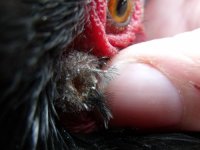
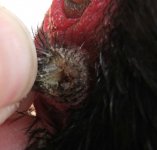
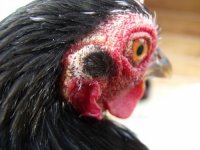
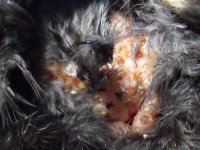
[ATTACH type="full" alt="B.JPG[/attachment
][attachment=5]A.JPG"]4[/ATTACH]
All 5 of my birds appear to be infested with northern Fowl Mite. After a phone consultation with the vet, it was suggested it was red mite. Due to the nature of the symptoms I have decided to treat for NFM as there are too many similarities for it to be red mite.
My pekin cockerel was affected the worst with a large cluster of greyish dusty matter firmly glued to the base of each feather around his vent and underbelly. The other 3 pekin girls were also in varying degrees of infestation, but our D'anver faired better, probably because she is far less fluffy. None of them had any under their wings, or on the backs of their necks, the vent area on each bird was mostly affected.
Immediately gave them all a 20 min warm soapy soak, which loosened the dead skin, which sadly came off in large sheets with perforations where the feathers had been. At the time I thought this was the egg sacs, but when dried I could see it was their skin. Their vents were covered in black scabs with very red red & sore/raw looking areas.......After 2 baths each, 2 rinses, frontline and sudocrem, 4 days on they are looking & acting much better, thankfully. Have pressure washed the houses, burnt the bedding and sprayed with Ardap. have got them on ACV and now adding vitamins to their drinking water, plus giving them extra mealworms. Also applied Xeno4540 to our rabbit, just in case.
How this happened all so quickly is beyond comprehension, and a total shock, as in 4 years of chicken keeping they have never had lice or mites. I am usually vigilant, and regularly use preventative measures but due to ill health have let my OH take over the daily routine during winter. So I havn't had my eye on the ball.
My questions now that the worst is over are:-
Is the crustiness on their faces and ears down to NFM or scaley face?
Should I continue with Frontline spray and WHEN should I give them another spray. (Applied on Tuesday.)
Have attached some photos taken after their baths, which are not very nice, but hopefully will shed some light. ALL advice/comments will be gratefully accepted, as this has completely taken me by surprise, and feel so terribly guilty that I have let my girls down to say the least.....




[ATTACH type="full" alt="B.JPG[/attachment
][attachment=5]A.JPG"]4[/ATTACH]

